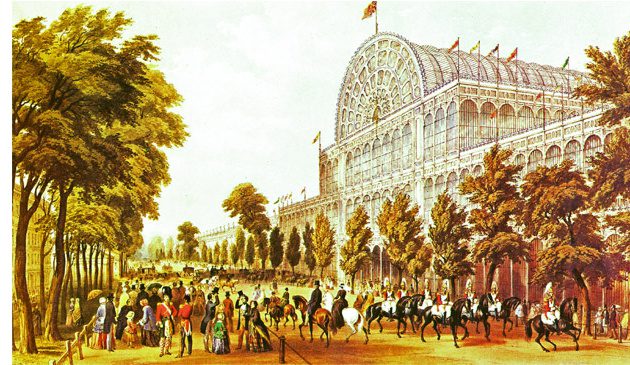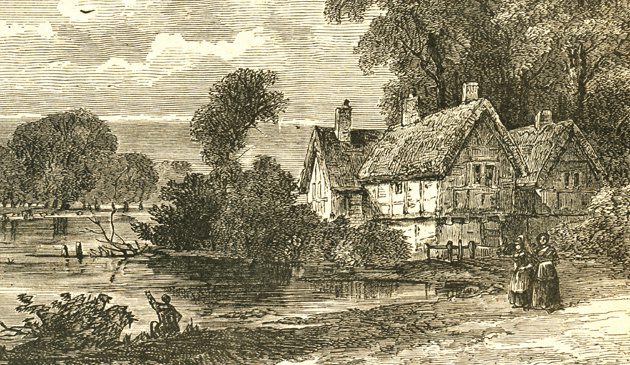St. James’s Park and Green Park – the making of the modern parks

The Temple of Peace in Green Park looking from the viewpoint of St. James’s Palace. It was created for the celebrations to mark the peace settlement of Aix le Chapelle in 1748 following the end of the War of the Austrian Succession. On the left of this contemporary print stands Buckingham House, the future royal palace. Constitution Hill passes from Green Park into St. James’s Park through the gate on the left of the temple. Hyde Park is in the background. Above the temple a thirty feet diameter representation of the sun stands on a fifty feet high pole, which was planned to illuminate the proceedings. Handel composed ‘Music for Royal Fireworks’ for the event.
In 1814 Napoleon had apparently been defeated, following his abdication and banishment to Elba. That year was also the centenary of when George I was invited to take the British throne. Great celebrations were planned in Hyde Park, Green Park and St. James’s Park in August to mark those events, overseen by Sir William Congreve. Mock naval battles took place on the Serpentine in Hyde Park. A vast castle was erected in Green Park for the celebrations. On the night it transformed into the ‘Temple of Concord’, signifying Britain’s path from war to peace, with an accompanying firework display. Anticipation mounted throughout the afternoon in expectation of the appearance of George, the Prince Regent.
The festivities in Hyde Park and Green Park were free but there was an entrance fee of half a guinea for those in St. James’s Park where the canal was lined by booths offering different types of refreshment. A Chinese-style bridge was erected across the canal, topped by a seven-storey pagoda designed by John Nash. It was illuminated by gaslights, still a novelty at that time. A firework display was set off at 10 o’clock to the thunder of cannons and lasting for two hours. Yet the prince snoozed in his palace and failed to appear for the festivities. Unfortunately, a firework set fire to the pagoda, causing the deaths of two workmen and injuring a number of people. The pagoda was reduced to a smouldering ruin just one storey high. The Temple of Concord was afterwards sold by auction for two-hundred pounds. The charred bridge remained for a few more years and thereafter the parks were neglected for over a decade. The Chinese bridge was soon in a state of decay. When asked what struck him most about his visit to England in 1823 the Italian sculptor Antonio Conova replied how the rather sad bridge in the park had been built by the government, in comparison to the splendid Waterloo Bridge, the work of a private company.
George, the Prince Regent, lived at Carlton House, which overlooked St. James’s Park from its north side. The house had originally been built in 1709 for Lord Carlton on Crown property. It became the home of the Prince in 1783 and he had it lavishly remodelled by Henry Holland and others from then until 1815. Despite spending a huge fortune on the house, he was finding it too small and instead concentrated on transforming Buckingham House into a grand palace.
In 1821, a year after his accession to the throne as George IV, the King’s favourite architect, John Nash, began drawing up plans to enlarge and remodel Buckingham House, inspired by the Tuileries in France. It was planned to be the climax of Nash’s transformation of the western side of London, which included Regent Street, Regent’s Park, and the Regent’s Canal. To raise some funds for the work at Buckingham Palace Carlton House was demolished and replaced with two rows of townhouses named Carlton House Terrace to be leased out to people of “the First Class”.
The work on Carlton House, and then Buckingham Palace, provided a stimulus to regenerate St. James’s Park. Nash transformed the canal into the present artificial lake, with a new bridge across the middle part (replaced in 1857 and 1957). A new Duck Island was created at the eastern end for waterfowl, replacing a previous series of islands. Gas lamps were installed in the park, an innovation that caused much excitement. The Mall and Constitution Hill were widened, forming a grand processional route and Wellington Arch was erected in the 1820s at the end of Constitution Hill, between Green Park and Hyde Park. The Wellington Barracks for the King’s Foot Guards was opened in 1833 at Birdcage Walk. At the time of the King’s death in 1830 work on the palace was still far from complete and considerably over budget so Nash was removed from the project.
Beside St. James’s Palace, overlooking the park, stands Clarence House. It was built between 1825 and 1827 to the design of John Nash for William, Duke of Clarence, the younger brother of George IV and future King William IV. It has continued as the London home of members of the royal family. Next to Clarence House, bordered by both Green Park and St. James’s Park stands Lancaster House. It was created in 1825 for the Duke of York & Albany (‘the Grand Old Duke of York’), second son of George III, and originally named York House. It is now part of the Foreign & Commonwealth Office.
There are several other notable buildings that border the east of Green Park. Spencer House was commissioned by the 1st Earl Spencer as a grand townhouse in 1756. It is still in the ownership of the Spencer family, currently the 9th Earl, brother of Princess Diana, but is leased to Lord Rothschild. The current Bridgewater House was designed by Charles Barry in 1840. The first known house on that site was built in the early 17th century for Thomas Howard, second son of the Earl of Suffolk. On the corner of Green Park and Piccadilly is the Ritz Hotel, which opened in 1906 on the site of the former Walsingham House Hotel.
In 1826 Green Park was officially opened to the public. The Ranger’s Lodge in Green Park was demolished and in 1855 the Queen’s Basin filled in. A cottage was completed on Duck Island in St. James’s Park in 1841 to house a bird-keeper from the Ornithological Society of London. It was restored in 1980 and is now occupied by the London Historic Parks & Gardens Trust. Carriages were only allowed on The Mall or Constitution Hill for a privileged few until the later 1880s when they were opened up as public highways.


